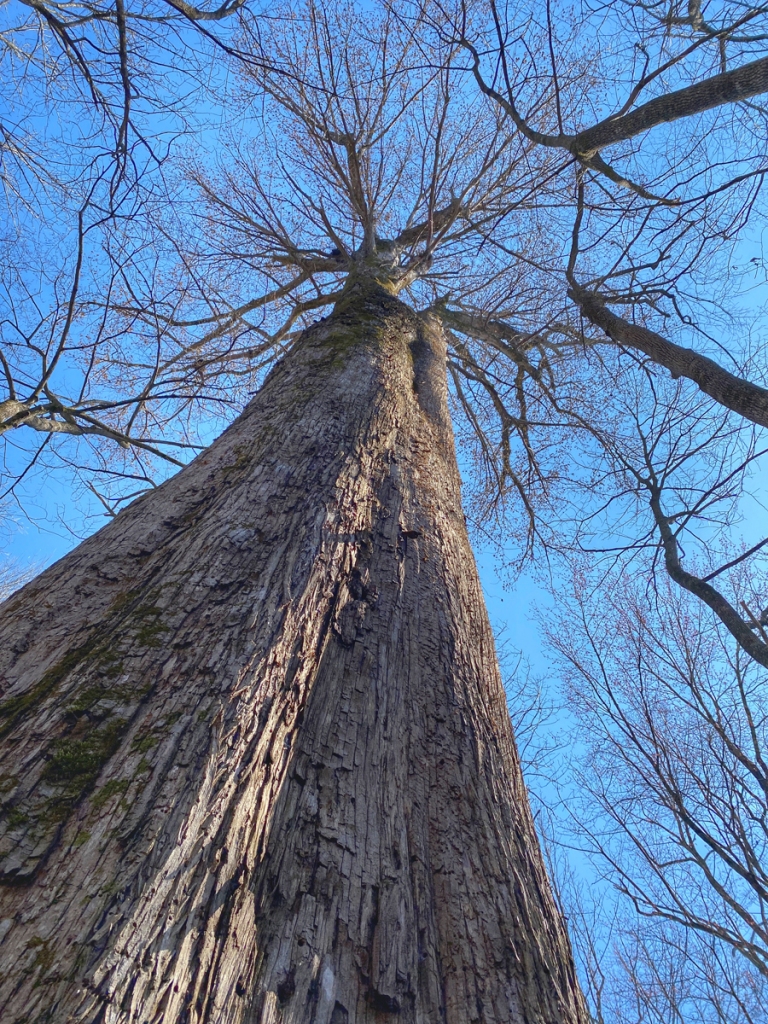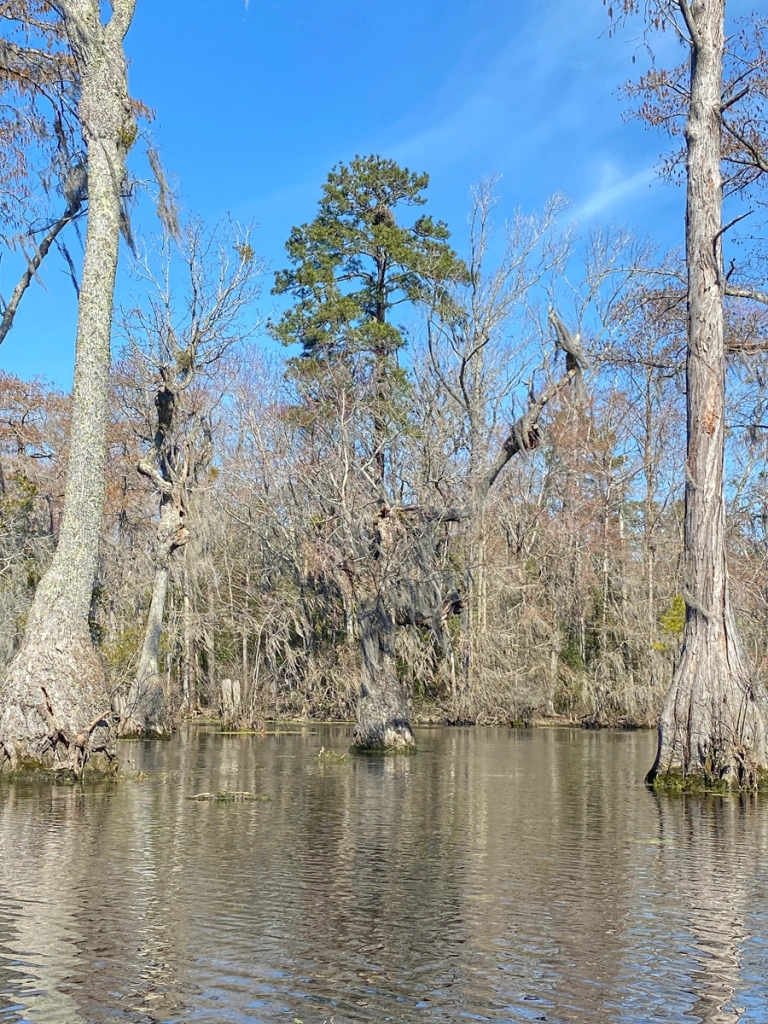Each of us needs to withdraw from the cares that will not withdraw from us. We need hours of aimless wandering…observing the mysterious world of ants and the canopy of treetops.
~Maya Angelou

Looking up through the trees at Pungo (click photos to enlarge)
It was certainly too cold for ants on my last trip, but not for enjoying the treetops. On my trips with clients I often feel the pressure to keep moving, to cover as much of the refuge as possible to increase our chances of seeing wildlife. When I have my own Pungo Time, I tend to wander and linger in an area for longer, just observing. I enjoy being a woods-watcher, looking closely at the details of a place, listening, sitting quietly and letting nature come to me. The forests of Pungo are challenging – there are relatively few places you can walk in them during the winter waterfowl season as many areas are closed to minimize human disturbance to wildlife. Other areas are so dense or so wet as to make walking next to impossible. But, there are a few paths where you can stroll along a dirt road next to the woods and peek in and see what is, or has been, going on in the forest.

Bald Eagle in dead tree at swan impoundment at sunrise
Of course, I also survey the edges of the forest as I am driving the refuge roads, and these trees, especially dead snags, are often quite productive. Bald Eagles like to perch in large trees at the edges of impoundments or fields where waterfowl congregate. Here, they can survey the scene in the hopes of spotting a weakling in the flock that might make an easy meal.

Turkey Vulture in early morning light
One section of forest edge has also been good for vultures early and late in the day, so I assume they have been roosting in this spot this winter. Even at some distance, their silhouettes can be distinguished from those of eagles because of their somewhat hunched appearance and the way they tend to hold their heads at a downward angle. If you can get a beak profile in your binoculars you can definitely discern the difference between the two species since an eagles’ beak appears much stronger and more massive.

Bears must love the sap and cambium of Sweet Gum trees
After an early morning drive through the refuge, I decided to head down one of my favorite paths and spend some time along the edge of the forest. This area is well known for the population of Black Bears that frequent the corn fields and associated woodland borders. There is so much bear sign here – almost every large tree has claw marks from scratching or climbing. Large Sweet Gum trees are particularly susceptible to bear activity and many show scars where bears have torn off sections of bark near the base. There are usually vertical teeth marks and often some horizontal claw marks. I think the bears must be going after the sweet sap and perhaps the cambium layer of these trees. It looks like this past year (I assume it happens mainly in spring when the sap is rising) has been a particularly busy one for bears with a sweet tooth. Surprisingly, I see most of these trees surviving years after this happens.

Young Black Bear standing next to tree
On a recent trip, I encountered a young bear as he was standing up against a large tree near the forest edge. I have seen this same young Black Bear several times this season in this same general area. But here he was apparently hugging a tree as if he wanted to climb it but was hesitant. He really paid me little mind but rather seemed more interested in something on the tree.

Bear puling at vine on tree
As I watched, I could see him sniff, then start mouthing something just out of my view around the trunk of the tree. It really wasn’t until I put down the camera and looked with binoculars that I could tell what it was – he was pulling at a Crossvine, a common semi-evergreen native vine of this area, and one I blogged about in 2013.

Bear puling at Crossvine
The bear walked part-way around the tree trunk, yanking and pulling the vine.

Bear eating Crossvine leaf
Once he got some of it down, he pulled it back around and stood up and appeared to eat a few of the leaves. Seems like a lot of effort for little reward to me, and, while I have heard deer will eat the leaves, I had not heard of bears eating them. But, young bears are particularly curious, so, even though there was a field of corn less than 200 feet away, this was perhaps a more pleasant way to spend some time while trying new things. On my next visit, I took my clients to this area, hoping to see the young bear again. Instead, we were privileged to spend some quality time quietly observing a mother bear with her two young cubs. The next day I went back to this area with high hopes for bears.

A young Black Bear sleeping in a tree
After walking a short distance I caught something out of the corner of my eye up in a large Tulip Poplar tree along the edge. Sure enough, it was the same young Black Bear I had seen on a few previous trips. This time, he seemed to be sound asleep high in a tree.

Looking back at me
When I walked around the tree for a closer look, the bear gave me one as well, peering down to see what was rustling leaves beneath its bed.

The young bear finally turned around and was in the sun
Not wanting to disturb its sleep, I went back around to the sunny side of the tree and waited. After about twenty minutes, the bear moved a bit, stood up, turned so its head was on my side of the tree, and laid back down.

Waking up
Another ten minutes went by as I watched the bear doze off and then open one eye to glance around. Finally, it raised up, checked on my whereabouts, and began to groom.

Time to groom
It apparently doesn’t take too long to ready yourself for an afternoon out in the forest (about 8 minutes for this bear after waking up). The short video below shows a few of the bear’s primping techniques.
During that time, the bear raised up, laid down, chewed its paws and belly, scratched a few times, and looked pretty relaxed while accomplishing all of this about 40 feet off the ground. The screechy sounds you hear in the video are from thousands of Red-winged Blackbirds that were sitting in nearby treetops. How did that bear sleep through all that?

Coming down
Finally, about 40 minutes after I first spotted the bear sleeping in a tree, it decided to climb down to spend time foraging on the forest floor below. That was my signal for me to move on and let the bear go about its business. I don’t want this young bear to become too comfortable around people, so I thought it better to let it be.

Another tree napper
I walked less than a hundred yards and noticed a well-camouflaged blob in a tree- this time a young Raccoon. I frequently advise clients to keep an eye out for sleeping Raccoons on our winter walks. I have found two others this winter, but they were both crammed into what seemed like uncomfortable positions in cracks and crevices of hollow trees. This one was out in the open, resting in the fork of a large tree trunk. I have noticed over the years that Raccoons like to sleep out in the open more on cold days with lots of sunshine and little wind.

Looking down at me
Like the bear, this little guy also had its best side toward me, so I walked around to look up and, once again, the tree-napper looked down the trunk at me.

The Raccoon turns around and faces the sun after being awakened
The young Raccoon slowly turned around and then began the same pattern of afternoon preparations that the nearby bear had done – a sequence of grooming. But, apparently, it takes a Raccoon a lot longer than a bear to get ready to head out.

This little guy had a lot of itches

You sometimes really have to reach to get that itch
I sat and watched the Raccoon take care of business for 45 minutes.

The big yawn
After all that, we were both a little tired, so I decided to continue on. I could hear the Tundra Swans and Snow Geese out on the lake starting to stir, so I headed back out into the open where I could more clearly view another component of this amazing habitat – the sky.

And the sky did not disappoint (more on that in the next post). The pink sky directed me to my car after what had been an incredible day at Pungo. A lone pine provided a stark silhouette to guide me back. It reminded me of a quote I found some time ago by an unknown author…
The young pine knows the secrets of the ground, the old pine knows the stars.
The old trees also know the habits of many of the forests’ wild creatures, and at least one woods-watcher on this day, one who is very grateful for the presence of these stately trees, and for the company they keep.























































